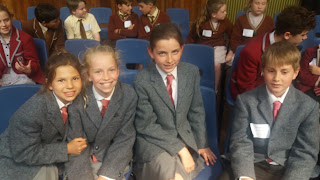Eighty-five schools were invited to take part in the Wycombe Abbey Chemistry Poster Competition, with the 120 best posters judged and only 15
girls being invited to take part in Chemistry Masterclass and Prizegiving
Lunch. Julia from Year 4 was one of those selected, so it was tremendous achievement for her to be within the best 15
girls today.
At the beginning of the Masterclass the girls were split
into 6 groups of 2 to 3 children. The
lesson started with explanation of what acid and alkaline is with examples from
every day life. Julia was the first one to put her hand put to talk about
acids. Then the girls had to work out how to identify them in the lab. Main
task was to make a red cabbage indicator. The children used universal
indicator, methyl orange and phenolphthalein to work out the changes made by
these indicators.
The red cabbage indicator was then used on five different
solutions to order them from the most acidic to most alkaline using changes in
colour. The solutions used were: jelly baby juice, lemon juice, persil washing
powder, toothpaste and washing up liquid.
Once the children mastered the use of the indicators
there were given a task of helping Pete, the painter who lost his paints and
needed to paint his girlfriend's house. Pete needed six different paints.
Children were provided with all necessary equipment and solutions: test tubes,
pipettes, universal indicator, hydrochloric acid, distilled water and sodium
hydroxide solution. Julia and her team successfully created six different paint
colours and were the first team to produce yellow colour which proved to be the
hardest.
All the girls with teachers and parents were invited to
join the School for lunch and prizegiving. It was truly special and exciting
day. Well done Julia!




























































